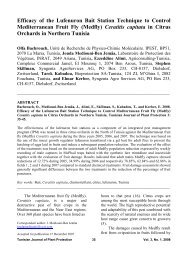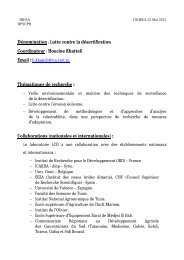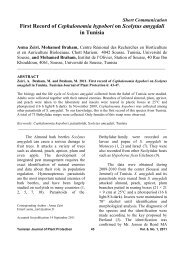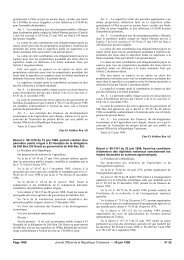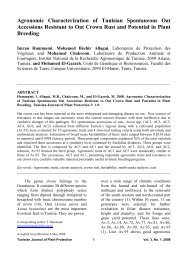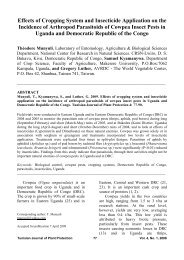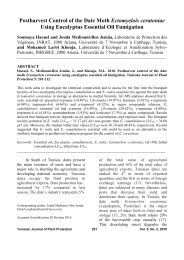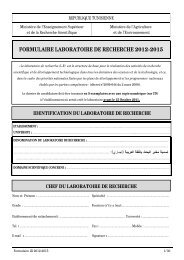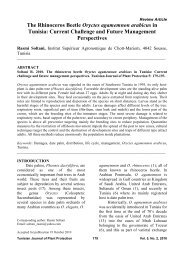Phenolic Compounds and their Role in Bio-control and ... - Iresa
Phenolic Compounds and their Role in Bio-control and ... - Iresa
Phenolic Compounds and their Role in Bio-control and ... - Iresa
You also want an ePaper? Increase the reach of your titles
YUMPU automatically turns print PDFs into web optimized ePapers that Google loves.
Review Article<br />
<strong>Phenolic</strong> <strong>Compounds</strong> <strong>and</strong> <strong>their</strong> <strong>Role</strong> <strong>in</strong> <strong>Bio</strong>-<strong>control</strong> <strong>and</strong><br />
Resistance of Chickpea to Fungal Pathogenic Attacks<br />
Mohamed Chérif, Arbia Arfaoui, <strong>and</strong> Azza Rhaiem, Laboratoire de<br />
Phytoapthologie, INAT, 43 Avenue Charles Nicolle, 1082 Cité Mahrajène, Tunis,<br />
Tunisia<br />
__________________________________________________________________________<br />
ABSTRACT<br />
Chérif, M., Arfaoui, A., <strong>and</strong> Rhaiem, A. 2007. <strong>Phenolic</strong> compounds <strong>and</strong> <strong>their</strong> role <strong>in</strong> bio-<strong>control</strong><br />
<strong>and</strong> resistance of chickpea to fungal pathogenic attacks. Tunisian Journal of Plant Protection 2:<br />
7-21.<br />
Chickpea is a major source of human <strong>and</strong> domestic animal food, particularly <strong>in</strong> develop<strong>in</strong>g countries.<br />
Chickpea may be attacked by different fungal diseases <strong>in</strong>clud<strong>in</strong>g Ascochyta blight, caused by<br />
Ascochyta rabiei, Fusarium wilt, caused by Fusarium oxysporum f. sp. ciceris (Foc), Botrytis grey<br />
mold, caused by Botrytis c<strong>in</strong>erea, rust, caused by Uromyces ciceris-ariet<strong>in</strong>i, collar rot, caused by<br />
Sclerotium rolfsii… These pathogens are difficult to <strong>control</strong> with cultural practices <strong>and</strong> chemical<br />
<strong>control</strong> is one of the most used approaches. <strong>Bio</strong>logical <strong>control</strong> <strong>and</strong> plant resistance, however, provide<br />
an environmentally <strong>and</strong> economically appropriate means for disease <strong>control</strong> that can be easily <strong>in</strong>cluded<br />
with<strong>in</strong> an <strong>in</strong>tegrated disease management strategy. In fact, the use of natural resistance for the<br />
management of fungal diseases <strong>in</strong> chickpea may be enhanced by means of biological <strong>control</strong> us<strong>in</strong>g<br />
either bacterial or fungal antagonists. Different bio<strong>control</strong> agents, <strong>in</strong>clud<strong>in</strong>g bacteria belong<strong>in</strong>g to the<br />
genera Bacillus, Pseudomonas <strong>and</strong> Rhizobium <strong>and</strong> fungi such as nonpathogenic <strong>and</strong> nonhost Fusarium<br />
species, have been used successfully <strong>and</strong> resulted <strong>in</strong> significant reduction <strong>in</strong> both pathogenic fungal<br />
growth <strong>in</strong> vitro <strong>and</strong> disease development <strong>in</strong> planta. Different studies showed that <strong>in</strong>duced resistance,<br />
through the accumulation of various phenolic compounds <strong>and</strong> phytoalex<strong>in</strong>s, as well as the activation of<br />
peroxidases, polyphenoloxidases <strong>and</strong> key enzymes <strong>in</strong> phenylpropanoid <strong>and</strong> isoflavonoid pathways, may<br />
play a crucial role <strong>in</strong> the biological <strong>control</strong> <strong>and</strong> resistance of chickpea to pathogenic attacks. For<br />
<strong>in</strong>stance, recent <strong>in</strong>vestigations revealed that the pre-treatment of chickpea seedl<strong>in</strong>gs with selected<br />
Rhizobium isolates before challenge with Foc, <strong>in</strong>creased significantly the levels of total phenolics <strong>and</strong><br />
the constitutive isoflavonoids, formononet<strong>in</strong>, <strong>and</strong> biochan<strong>in</strong> A. Protection of chickpea aga<strong>in</strong>st Fusarium<br />
wilt by the nonpathogenic <strong>and</strong> nonhost Fusarium species was shown to be associated with the<br />
<strong>in</strong>duction of the synthesis of the phytoalex<strong>in</strong>s medicarp<strong>in</strong> <strong>and</strong> maachia<strong>in</strong> <strong>and</strong> the related isoflavones<br />
formononet<strong>in</strong> <strong>and</strong> biochan<strong>in</strong> A. Maakia<strong>in</strong> <strong>and</strong> medicarp<strong>in</strong> exhibited potent anti-fungal activity towards<br />
Fusarium spores, by <strong>in</strong>hibit<strong>in</strong>g <strong>their</strong> germ<strong>in</strong>ation <strong>and</strong> hyphal growth. Studies on phytoalex<strong>in</strong> tolerance<br />
<strong>in</strong> chickpea pathogenic fungi have also shown a relationship between virulence <strong>and</strong> the ability of these<br />
fungi to detoxify phytoalex<strong>in</strong>s. This was examplified by the fact that the fungus Nectria heamatococca<br />
can metabolise <strong>and</strong> detoxify maakia<strong>in</strong> <strong>and</strong> medicarp<strong>in</strong> <strong>and</strong> that these reactions are required for<br />
pathogenesis by this fungus on chickpea. Among the other phenolic compounds studied, gallic,<br />
c<strong>in</strong>namic, ferulic, <strong>and</strong> chlorogenic acids were also associated with the protection of chickpea from<br />
fungal attacks through <strong>in</strong>duced resistance. Of the <strong>in</strong>duced defenses, phenolics <strong>and</strong> phytoalex<strong>in</strong><br />
production have received a particular attention <strong>in</strong> chickpea. However, more efforts are needed to<br />
provide good evidence that these compounds accumulate at the right time, concentration, <strong>and</strong> location<br />
<strong>and</strong> to elucidate the regulatory genes <strong>in</strong>volved <strong>in</strong> <strong>their</strong> rapid <strong>and</strong> coord<strong>in</strong>ated <strong>in</strong>duction <strong>in</strong> response to<br />
fungal attack.<br />
Keywords: Chickpea, phenolics, phytoalex<strong>in</strong>s, bio<strong>control</strong>, resistance, fungal diseases.<br />
__________________________________________________________________________<br />
Tunisian Journal of Plant Protection 7<br />
Vol. 2, No. 1, 2007
Chickpea (Cicer ariet<strong>in</strong>um L.) is,<br />
after soybean <strong>and</strong> pea, the third most<br />
important gra<strong>in</strong> legume crop <strong>in</strong> the world<br />
<strong>and</strong>, along with French bean, soybean <strong>and</strong><br />
alfalfa, one of the legume plants the most<br />
studied at the biochemical level for<br />
phenolics <strong>and</strong> phytoalex<strong>in</strong> responses (4,<br />
27). This plant is native of Syria, Southeastern<br />
Turkey <strong>and</strong> around the<br />
Mediterranean Bas<strong>in</strong>, <strong>and</strong> constitutes a<br />
very important legume crop <strong>in</strong> North<br />
Africa (56, 73). In develop<strong>in</strong>g countries,<br />
it is an important source of high-quality<br />
prote<strong>in</strong> for the poorer <strong>in</strong>habitants.<br />
Chickpea is able to grow under poor soil<br />
conditions <strong>and</strong> can therefore be grown on<br />
marg<strong>in</strong>al l<strong>and</strong>s, where, ow<strong>in</strong>g to its<br />
capacity to fix nitrogen, it improves soil<br />
fertility (64). Chickpea occupies more<br />
than 10 million hectares of the cultivated<br />
areas <strong>in</strong> the world, with a total production<br />
of approximately 7 million tons <strong>and</strong> an<br />
average yield of 700 kg/ha (65, 66). Low<br />
yields are attributed to different factors,<br />
among which pathogenic microorganisms<br />
<strong>and</strong> <strong>in</strong>sect attacks are<br />
considered the most serious. Nene <strong>and</strong><br />
Reddy (57), reported many chickpea<br />
natural enemies, <strong>in</strong>clud<strong>in</strong>g 47 pathogens<br />
<strong>and</strong> 50 <strong>in</strong>sects. Ascochyta blight of<br />
chickpea caused by Ascochyta rabiei,<br />
grey mould caused by Botrytis c<strong>in</strong>erea,<br />
rust caused by Uromyces ciceris-ariet<strong>in</strong>i<br />
<strong>and</strong> Alternaria alternata <strong>and</strong> Stemphylium<br />
sarc<strong>in</strong>iforme attacks are considered as the<br />
most important <strong>and</strong> destructive foliar<br />
diseases of chickpea (60). As soil-borne<br />
fungi, Fusarium oxysporum f. sp. Ciceris<br />
(Foc), the causal agent of Fusarium wilt<br />
of chickpea, F. solani, F. eumartii,<br />
Rhizoctonia bataticola, Scleritium rolfsii,<br />
Pythium ultimum <strong>and</strong> Verticillium albo-<br />
Correspond<strong>in</strong>g author: M. Chérif<br />
cherif.mohamed@<strong>in</strong>at.agr<strong>in</strong>et.tn<br />
Accepted for publication 30 July 2007.<br />
atrum are reported to be the most<br />
pathogenic (57). Besides these fungal<br />
enemies, chickpea may be attacked by<br />
more than 16 viruses <strong>and</strong> different<br />
pathogenic bacteria, <strong>in</strong>clud<strong>in</strong>g<br />
Xanthomonas campestris pv. cassiae,<br />
which is especially destructive on earlysown<br />
chickpea, <strong>and</strong> nematodes, such as<br />
Meloidogyne <strong>in</strong>cognita, M. javanica, M.<br />
artiellia <strong>and</strong> Pratylenchus thornei (15,<br />
57). Despite the important number of<br />
chickpea natural enemies, Ascochyta<br />
blight <strong>and</strong> Fusarium wilt are always<br />
considered as respectively the first <strong>and</strong><br />
the second most destructive diseases of<br />
chickpea (33, 59). Seeds <strong>in</strong>fected by these<br />
pathogens are one of the ma<strong>in</strong> sources of<br />
<strong>in</strong>oculum <strong>and</strong> can be responsible of the<br />
<strong>in</strong>troduction of these pathogens <strong>in</strong>to<br />
disease-free areas. Therefore, plant<strong>in</strong>g<br />
pathogen free seed is the primary means<br />
to limit the <strong>in</strong>troduction of these<br />
pathogens <strong>in</strong>to a field <strong>and</strong> prevent the<br />
establishment of these diseases (64).<br />
Nevertheless, un<strong>in</strong>fected or treated seeds<br />
are not sufficient to prevent plants<br />
<strong>in</strong>fection dur<strong>in</strong>g the grow<strong>in</strong>g season. In<br />
fact, diseased debris <strong>and</strong> <strong>in</strong>fected crop<br />
residues overw<strong>in</strong>ter<strong>in</strong>g <strong>in</strong> <strong>and</strong> on the soil<br />
represent an efficient mechanism for the<br />
survival of these fungi from one season to<br />
another (35, 55). Cultural practices, such<br />
as plant<strong>in</strong>g date, sow<strong>in</strong>g density <strong>and</strong> crop<br />
rotation proved to be very effective <strong>in</strong><br />
reduc<strong>in</strong>g fungal attacks, but they are<br />
<strong>in</strong>sufficient under high disease pressure,<br />
especially when weather conditions are<br />
particularly conducive to disease<br />
development. Among other <strong>control</strong><br />
measures, such as fungicide treatments<br />
which are prohibitively expensive besides<br />
the problems relative to environmental<br />
pollution, chemical toxicity to humans<br />
<strong>and</strong> animals <strong>and</strong> fungal resistance, the use<br />
of resistant cultivars is probably the best<br />
way to manage these diseases (57). Many<br />
breed<strong>in</strong>g <strong>and</strong> screen<strong>in</strong>g programs have<br />
been undertaken <strong>in</strong> order to obta<strong>in</strong><br />
chickpea varieties with high levels of<br />
resistance to the major diseases of<br />
chickpea (18, 33, 40). However, the<br />
Tunisian Journal of Plant Protection 8<br />
Vol. 2, No. 1, 2007
effectiveness of host resistance is<br />
curtailed by the presence or the<br />
appearance of virulent races of the<br />
pathogen, which is the case of Foc (14,<br />
39), or by the absence of complete<br />
resistance to the pathogen, case of<br />
Ascochyta blight where cultivars range <strong>in</strong><br />
susceptibility to the disease (58).<br />
<strong>Bio</strong>logical <strong>control</strong> of chickpea<br />
major diseases. The use of resistant<br />
cultivars for management of chickpea<br />
diseases may be enhanced by biological<br />
<strong>control</strong> us<strong>in</strong>g either bacterial or fungal<br />
antagonists. Effective bio<strong>control</strong> of<br />
Ascochyta blight <strong>and</strong> Fusarium wilt of<br />
chickpea was achieved <strong>in</strong> our laboratory<br />
by us<strong>in</strong>g bacteria belong<strong>in</strong>g respectively<br />
to the genera Bacillus <strong>and</strong> Rhizobium (1).<br />
Seventy-eight Bacillus isolates, most of<br />
which isolated from salty soils <strong>in</strong> Tunisia,<br />
were assessed <strong>in</strong> planta for <strong>their</strong><br />
antagonistic activity aga<strong>in</strong>st Ascochyta<br />
rabiei. Fungicides, such as Azoxystrob<strong>in</strong><br />
(Quadris), Chlorothalonil (Banko) <strong>and</strong><br />
Kresoxym-Methyl (Fl<strong>in</strong>t), were <strong>in</strong>cluded<br />
<strong>in</strong> these experiments for comparison.<br />
Eleven of the tested isolates of Bacillus<br />
spp. appeared to be the most effective <strong>in</strong><br />
reduc<strong>in</strong>g disease severity. Disease attack<br />
<strong>and</strong> severity recorded on the plants<br />
<strong>in</strong>oculated with these bacteria were<br />
significantly lower than those of the<br />
tested fungicides <strong>and</strong> the <strong>in</strong>oculated<br />
<strong>control</strong>. Moreover, these antagonists<br />
improved plant growth parameters,<br />
<strong>in</strong>clud<strong>in</strong>g the percentage of seedl<strong>in</strong>g<br />
emergence, plant height <strong>and</strong> plant weight.<br />
Arfaoui et al. (1) studied the<br />
antagonistic activities of 21 Rhizobium<br />
isolates <strong>in</strong> vitro <strong>in</strong> dual culture, <strong>and</strong> <strong>in</strong><br />
vivo under greenhouse <strong>and</strong> field<br />
conditions aga<strong>in</strong>st Foc race 0. In dual<br />
culture, 19 of these isolates <strong>in</strong>hibited the<br />
mycelial growth of the pathogen result<strong>in</strong>g<br />
<strong>in</strong> the case of the most effective isolates<br />
<strong>in</strong> a percentage of growth <strong>in</strong>hibition<br />
higher than 50%. Greenhouse <strong>and</strong> field<br />
experiments undertaken by these authors,<br />
us<strong>in</strong>g the susceptible ILC482 <strong>and</strong> the<br />
moderately resistant INRAT 87/1<br />
cultivars of chickpea, revealed the<br />
effectiveness of some of these isolates <strong>in</strong><br />
reduc<strong>in</strong>g the percentage of wilted plants.<br />
In the greenhouse, the most effective<br />
Rhizobium isolate PchDMS reduced the<br />
percentage of wilted plants from more<br />
than 79% <strong>in</strong> the <strong>in</strong>oculated <strong>control</strong> to<br />
12.5% <strong>in</strong> the susceptible cultivar ILC482<br />
<strong>and</strong> from more than 54% to 8.3% <strong>in</strong> the<br />
moderately resistant cultivar INRAT<br />
87/1. Field experiments showed that <strong>in</strong><br />
presence of the susceptible chickpea<br />
cultivar, although most of the studied<br />
Rhizobium isolates reduced the<br />
percentage of wilted plants, these<br />
reductions were not significantly<br />
different. However, very <strong>in</strong>terest<strong>in</strong>g<br />
results were achieved <strong>in</strong> presence of the<br />
moderately resistant cultivar INRAT<br />
87/1. For <strong>in</strong>stance, Rhizobium isolate<br />
Pch43, which was very effective under<br />
greenhouse conditions, reduced the<br />
percentage of diseased plants from more<br />
than 48.6% <strong>in</strong> <strong>in</strong>fected <strong>control</strong> plants to<br />
less than 8% <strong>in</strong> plants <strong>in</strong>oculated with the<br />
bacteria <strong>and</strong> <strong>in</strong>fected with the pathogen.<br />
The best protection aga<strong>in</strong>st disease was<br />
obta<strong>in</strong>ed with isolates Pch43 <strong>and</strong> Rh4,<br />
which reduced the percentage of wilted<br />
plants to less than 8%. Besides <strong>their</strong><br />
beneficial effects on disease <strong>control</strong>, these<br />
studies showed that Rhizobium isolates<br />
may improve plant growth <strong>and</strong> yield.<br />
<strong>Bio</strong>logical <strong>control</strong> by us<strong>in</strong>g nonhost F.<br />
oxysporum isolates <strong>and</strong> <strong>in</strong>compatible<br />
races of the same forma specialis<br />
constitutes also a promis<strong>in</strong>g strategy for<br />
the management of Fusarium wilt of<br />
chickpea (14, 36, 37). Prior <strong>in</strong>oculation of<br />
germ<strong>in</strong>ated chickpea seeds with nonhost<br />
F. oxysporum isolates or <strong>in</strong>compatible<br />
Foc races protected effectively chickpea<br />
plants aga<strong>in</strong>st a highly virulent isolate of<br />
Foc race 5 (36). These results were<br />
confirmed by the studies of Cach<strong>in</strong>era et<br />
al. (14), who showed that <strong>in</strong>oculation of<br />
germ<strong>in</strong>ated seeds with these antagonists<br />
delayed the onset of symptoms <strong>and</strong><br />
significantly reduced the f<strong>in</strong>al amount of<br />
Fusarium wild caused by race 5.<br />
Tunisian Journal of Plant Protection 9<br />
Vol. 2, No. 1, 2007
A grow<strong>in</strong>g body of evidence from<br />
several studies revealed that different<br />
mechanisms may be <strong>in</strong>volved <strong>in</strong> the<br />
biological <strong>control</strong> of plant diseases by<br />
bacterial <strong>and</strong> fungal antagonists. These<br />
mechanisms may <strong>in</strong>clude antibiosis,<br />
direct parasitism, saprophytic competition<br />
for nutrients, competition for <strong>in</strong>fection<br />
sites, <strong>and</strong> <strong>in</strong>duced or enhanced host<br />
resistance (19, 22, 23, 30). These<br />
different modes of action are not<br />
necessarily exclusive of one another, <strong>and</strong><br />
many of these mechanisms may be<br />
synergistically active <strong>and</strong> used by the<br />
same bio-<strong>control</strong> agent (22, 48). As far as<br />
chickpea is concerned, different<br />
<strong>in</strong>vestigations showed that <strong>in</strong>duced<br />
resistance, through the accumulation of<br />
various phenolic compounds <strong>and</strong><br />
phytoalex<strong>in</strong>s, de novo synthesis of<br />
pathogenesis-related prote<strong>in</strong>s as well as<br />
the activation of different enzymes such<br />
as chit<strong>in</strong>ases, ß-1,3-glucanases,<br />
peroxidases, polyphenoloxidases <strong>and</strong> key<br />
enzymes <strong>in</strong> phenylpropanoid <strong>and</strong><br />
isoflavonoid pathways, may play a crucial<br />
role <strong>in</strong> the biological <strong>control</strong> of chickpea<br />
diseases by antagonistic microorganisms<br />
(2, 3, 4, 6, 13, 14). In this bibliographic<br />
study we will focus on the roles of<br />
<strong>in</strong>duced phenolic compounds <strong>and</strong><br />
phytoalex<strong>in</strong>s <strong>in</strong> the <strong>in</strong>teraction of<br />
chickpea with bacterial <strong>and</strong> fungal<br />
antagonistic agents which should lead to<br />
biological <strong>control</strong> of the major diseases of<br />
this plant.<br />
<strong>Phenolic</strong> compounds <strong>in</strong> plants.<br />
Plants have the ability to synthesize a<br />
large number of aromatic substances,<br />
most of which are phenols or <strong>their</strong><br />
oxygen-substituted derivatives (24). Most<br />
are secondary metabolites, which may be<br />
<strong>in</strong> the form of simple phenols <strong>and</strong><br />
phenolic acids, qu<strong>in</strong>ones, flavones,<br />
flavonoids, flavonols, tann<strong>in</strong>s, terpenoids,<br />
essential oils, alkaloids… All of the<br />
phenolics have one or more benzene r<strong>in</strong>gs<br />
with one or more hydroxyl groups that<br />
may be variously elaborated with methyl,<br />
methoxyl, am<strong>in</strong>o or glycosyl groups.<br />
Some, such as terpenoids, give plants<br />
<strong>their</strong> odors <strong>and</strong> flavor; many compounds,<br />
like tann<strong>in</strong>s <strong>and</strong> qu<strong>in</strong>ones, are responsible<br />
for plant pigment, <strong>and</strong> others, such as<br />
some alkaloids, may be toxic to the<br />
consumer. In many <strong>in</strong>stances, these<br />
substances serve as plant defense<br />
mechanisms aga<strong>in</strong>st predation by <strong>in</strong>sects,<br />
herbivores <strong>and</strong> microorganisms (11, 24,<br />
74). Different studies showed that there<br />
are often large <strong>in</strong>creases <strong>in</strong> phenolic<br />
synthesis <strong>in</strong> plants after attack by plant<br />
pathogens (26, 49). <strong>Phenolic</strong>s that occur<br />
constitutively <strong>and</strong> function as preformed<br />
<strong>in</strong>hibitors are generally referred to as<br />
phytoanticip<strong>in</strong>s, <strong>and</strong> those that are<br />
produced <strong>in</strong> response to <strong>in</strong>fection by the<br />
pathogen are called phytoalex<strong>in</strong>s <strong>and</strong><br />
constitute an active defense response. In<br />
resistant plants, phenolic based defense<br />
responses are characterized by the early<br />
<strong>and</strong> rapid accumulation of phenolics at<br />
the <strong>in</strong>fection site result<strong>in</strong>g <strong>in</strong> the effective<br />
isolation of the pathogen (20, 21, 28, 29).<br />
These physical responses may <strong>in</strong>clude the<br />
elaboration of cell wall thicken<strong>in</strong>gs <strong>and</strong><br />
appositions, such as papillae, as well as<br />
the occlusion of plant vessels. These<br />
reactions are usually accompanied by the<br />
synthesis <strong>and</strong> deposition of lign<strong>in</strong>, a<br />
polymer of aromatic phenolics. Results<br />
from many studies suggest that<br />
esterification of phenols to cell wall<br />
materials <strong>and</strong> the accumulation <strong>and</strong><br />
deposition of phenols <strong>in</strong> <strong>and</strong> on cell walls<br />
is usually considered as an <strong>in</strong>crease <strong>in</strong><br />
resistance to fungal hydrolytic enzymes<br />
as well as a physical barrier aga<strong>in</strong>st<br />
fungal penetration.<br />
<strong>Phenolic</strong>s present <strong>in</strong> healthy,<br />
un<strong>in</strong>fected plant tissues, as preformed<br />
antimicrobial compounds, that <strong>in</strong>hibit the<br />
growth of fungi may <strong>in</strong>clude simple<br />
phenols, phenolic acids, flavonols, some<br />
isoflavones… Those that are <strong>in</strong>duced <strong>in</strong><br />
response to fungal <strong>in</strong>fection <strong>in</strong>clude<br />
phenolic phytoalex<strong>in</strong>s, isoflavonoids,<br />
pterocarpans, furocoumar<strong>in</strong>s, flavans,<br />
stilbenes, phenanthrenes… (43). All the<br />
above mentioned compounds orig<strong>in</strong>ate<br />
through different branches of the general<br />
Tunisian Journal of Plant Protection 10<br />
Vol. 2, No. 1, 2007
phenylpropanoid pathway, lead<strong>in</strong>g to the<br />
elaboration of various hydroxyc<strong>in</strong>namic<br />
acids <strong>and</strong> derivatives with antifungal<br />
activity. Confrontation of many of these<br />
compounds with fungi <strong>in</strong> vitro revealed<br />
<strong>their</strong> effectiveness <strong>in</strong> reduc<strong>in</strong>g fungal<br />
growth (Table 1). These studies seem also<br />
to <strong>in</strong>dicate that hydroxyc<strong>in</strong>namaldehydes<br />
are more fungitoxic than<br />
hydroxyc<strong>in</strong>namic acids <strong>and</strong><br />
hydroxyc<strong>in</strong>namyl alcohols (9). Among<br />
the c<strong>in</strong>namics, caffeic <strong>and</strong> coumaric acids<br />
are widely distributed <strong>in</strong> plants occurr<strong>in</strong>g<br />
naturally <strong>in</strong> comb<strong>in</strong>ation with other<br />
compounds, usually <strong>in</strong> the form of esters.<br />
For <strong>in</strong>stance chlorogenic acid, the ester of<br />
caffeic with qu<strong>in</strong>ic acid, <strong>and</strong> ferulic acid<br />
were shown to be strong <strong>in</strong>hibitors of<br />
different fungal pathogens (43). Benzoic<br />
derivatives, such as 2,5-<br />
Dihydroxybenzoic acid <strong>and</strong> 2,5-<br />
dimetoxybenzoic acid, were very<br />
effective <strong>in</strong> <strong>in</strong>hibit<strong>in</strong>g both spore<br />
germ<strong>in</strong>ation <strong>and</strong> mycelial growth of<br />
different pathogenic fungi, <strong>in</strong>clud<strong>in</strong>g B.<br />
c<strong>in</strong>erea, Sclerot<strong>in</strong>ia sclerotiorum, F.<br />
oxysporum, <strong>and</strong> Penicillium digitatum,<br />
Gleosporium album, <strong>in</strong> vitro, <strong>and</strong> <strong>in</strong><br />
<strong>control</strong>l<strong>in</strong>g disease development <strong>in</strong> vivo<br />
(44). <strong>Phenolic</strong>s seem to <strong>in</strong>hibit disease<br />
development through different<br />
mechanisms <strong>in</strong>volv<strong>in</strong>g the <strong>in</strong>hibition of<br />
extracellular fungal enzymes (cellulases,<br />
pect<strong>in</strong>ases, laccase, xylanase,…),<br />
<strong>in</strong>hibition of fungal oxidative<br />
phosphorylation, nutrient deprivation<br />
(metal complexation, prote<strong>in</strong><br />
<strong>in</strong>solubilisation), <strong>and</strong> antioxidant activity<br />
<strong>in</strong> plant tissues (38, 47, 67). Lipophilic<br />
properties <strong>and</strong> the presence of a hydroxyl<br />
group <strong>in</strong> phenolics seem to play a major<br />
role <strong>in</strong> <strong>their</strong> antifungal activity, allow<strong>in</strong>g<br />
respectively the penetration of biological<br />
membranes <strong>and</strong> oxidative<br />
phosphorylation uncoupl<strong>in</strong>g.<br />
Table 1. <strong>Phenolic</strong> compounds active <strong>in</strong> vitro aga<strong>in</strong>st some plant pathogenic fungi<br />
Compound Target organism References<br />
Essential oils<br />
Penicillium spp., Botrytis c<strong>in</strong>erea,<br />
Fusarium oxysporum, Alternaria<br />
spp.<br />
Arras <strong>and</strong> Usai (7), Arras et al. (8),<br />
Reddy et al. (63)<br />
C<strong>in</strong>namic derivatives<br />
C<strong>in</strong>namic acid; 4-Coumaric acid; 3-<br />
Coumaric acid; Dihydrocaffeic acid;<br />
Ferulic acid; S<strong>in</strong>apic acid.<br />
Sclerot<strong>in</strong>ia sclerotirum; Alternaria<br />
spp; B. c<strong>in</strong>erea; Penicillium<br />
digitatum<br />
Lattanzio et al. (42)<br />
Flavonoids<br />
Apigen<strong>in</strong>-7-glucoside; (+)-Catech<strong>in</strong>;<br />
Luteoll<strong>in</strong>-7-glucoside; Myricet<strong>in</strong>;<br />
Quercet<strong>in</strong>-3-rhamnoside; Quercet<strong>in</strong>-<br />
3-rut<strong>in</strong>oside.<br />
Alternaria spp.; Penicillium<br />
digitatum<br />
Lattanzio et al. (42)<br />
Benzoic derivatives<br />
Gallic acid; Syr<strong>in</strong>gic acid; 4-<br />
Hydroxybenzoic acid; 2,3-; 3,4- <strong>and</strong><br />
2,5-Dihydroxybenzoic acid; 2,3-; 2,4-<br />
<strong>and</strong> 2,5- Dimethoxybenzoic acid.<br />
Alternaria spp.; B. c<strong>in</strong>erea;<br />
Penicillium digitatum<br />
Lattanzio et al. (42)<br />
Benzaldehyde; Methyl salicylate;<br />
Ethyl benzoate.<br />
Monilia fructicola; M. laxa; B.<br />
c<strong>in</strong>erea<br />
Ton<strong>in</strong>i <strong>and</strong> Caccioni (72), Wilson et<br />
al. (75)<br />
Tunisian Journal of Plant Protection 11<br />
Vol. 2, No. 1, 2007
Major phenolic compounds <strong>in</strong><br />
legumes. The isoflavonoids, unlike most<br />
other flavonoids, show a very limited<br />
distribution <strong>in</strong> the plant k<strong>in</strong>gdom, be<strong>in</strong>g<br />
largely conf<strong>in</strong>ed to the legumes. Most of<br />
the biologically active isoflavonoids have<br />
been isolates from the legumes but this<br />
not preclude f<strong>in</strong>d<strong>in</strong>g them <strong>in</strong> other plant<br />
families. Isoflavonoids are synthesized as<br />
part of the phenylpropanoid pathway <strong>and</strong><br />
they show a wide range of biological<br />
activities. The three most important are<br />
the oestrogenic activities of simple<br />
isoflovonoids <strong>and</strong> coumestans, the<br />
<strong>in</strong>secticidal properties of rotenoids, <strong>and</strong><br />
the antifungal <strong>and</strong> antibacterial properties<br />
of phytoalex<strong>in</strong>s (73). Isoflavonoids play a<br />
key role <strong>in</strong> plant-microbe <strong>in</strong>teractions,<br />
serv<strong>in</strong>g as the signal molecule for<br />
establish<strong>in</strong>g the symbiotic relationship<br />
between plants <strong>and</strong> rhizobial bacteria that<br />
results <strong>in</strong> the formation of nitrogen-fix<strong>in</strong>g<br />
root nodules. They are also the precursors<br />
to the major phytoalex<strong>in</strong>s <strong>in</strong> legumes,<br />
<strong>in</strong>dicat<strong>in</strong>g that the activation of <strong>their</strong><br />
synthesis dur<strong>in</strong>g the <strong>in</strong>teraction of<br />
resistant plants with the pathogen<br />
provides a battery of defense compounds.<br />
Isoflavones <strong>and</strong> ptericarpans are the two<br />
largest of the about twelve classes<br />
constitut<strong>in</strong>g isoflavonoids. The four<br />
commonest isoflavones are daidze<strong>in</strong><br />
(1,7,4’-trihydroxyisoflavone),<br />
formononet<strong>in</strong> (2,7-hydroxy-4’-<br />
methoxyisoflavone) (Fig. 1), geniste<strong>in</strong><br />
(3,5,7,4’-tridydroxyisoflavone) <strong>and</strong><br />
biochan<strong>in</strong> A (4,5,7-dihydroxy-4’-<br />
methoxyisoflavone) (Fig. 1).<br />
Isoflavanones are less frequent than<br />
isoflavones <strong>and</strong> most of the products so<br />
far reported <strong>in</strong> the literature have<br />
antifungal activity, <strong>and</strong> have been<br />
characterized from phytoalex<strong>in</strong><br />
<strong>in</strong>vestigations. Simple isoflavanones<br />
<strong>in</strong>clude<br />
dehydrodeidze<strong>in</strong>,<br />
dihydroformononet<strong>in</strong><br />
<strong>and</strong><br />
dihydrobiochan<strong>in</strong> A. Most of ptericarpans<br />
have been also isolated as phytoalex<strong>in</strong>s<br />
<strong>and</strong> exhibit both antifungal <strong>and</strong> optical<br />
activity. They are conveniently devided<br />
<strong>in</strong>to the ptericarpans, the 6ahydroxyptericarpans,<br />
<strong>and</strong> the<br />
ptericarpenes (73). Medicarp<strong>in</strong> (Fig. 1), a<br />
phytoalex<strong>in</strong> <strong>in</strong> many legume species, is<br />
undoubtedly the most widespread<br />
pterocarpan. Among the 27 members of<br />
the 6a-hydroxyptericarpans, pisat<strong>in</strong> was<br />
the first phytoalex<strong>in</strong> of this group isolated<br />
from pods of Pisum sativum (76). Over<br />
400 legumes have been studied for<br />
phytoalex<strong>in</strong>s synthesis <strong>and</strong> most<br />
responded positively, with the production<br />
of one or more isoflavonoids.<br />
Induction of phenolic compounds<br />
<strong>and</strong> phytoalex<strong>in</strong>s <strong>in</strong> chickpea. As<br />
<strong>in</strong>dicated previously, different studies<br />
showed that <strong>in</strong>duced resistance, through<br />
the accumulation of various phenolic<br />
compounds <strong>and</strong> phytoalex<strong>in</strong>s, as well as<br />
the activation of oxidative <strong>and</strong> key<br />
enzymes <strong>in</strong> phenylpropanoid <strong>and</strong><br />
isoflavonoid pathways, may play a crucial<br />
role <strong>in</strong> the biological <strong>control</strong> <strong>and</strong><br />
resistance of chickpea to pathogenic<br />
attacks (2, 4, 13, 14). Plant protection by<br />
the bio<strong>control</strong> agents was generally<br />
associated with the accumulation of<br />
mRNA of defense genes, <strong>in</strong>clud<strong>in</strong>g the<br />
phenylpropanoid pathway gene encod<strong>in</strong>g<br />
phenylalan<strong>in</strong>e ammonia lyase (PAL), <strong>and</strong><br />
secondary metabolites of phenolic nature<br />
(70). In the same context, S<strong>in</strong>gh et al.<br />
(69), reported that treatment of chickpea<br />
seeds with Pseudomonas spp. <strong>in</strong>creased<br />
the synthesis of c<strong>in</strong>namic, ferulic <strong>and</strong><br />
chlorogenic acids, which showed<br />
antifungal effects aga<strong>in</strong>st Sclerotium<br />
rolfsii. Investigations, conducted recently<br />
<strong>in</strong> our laboratory, revealed that the pretreatment<br />
of chickpea seedl<strong>in</strong>gs with<br />
selected Rhizobium isolates before<br />
challenge with Foc, <strong>in</strong>creased<br />
significantly the levels of peroxidases<br />
(POX), polyphenoloxidases (PPO), total<br />
phenolics <strong>and</strong> the constitutive<br />
isoflavonoids, formononet<strong>in</strong> <strong>and</strong><br />
biochan<strong>in</strong> A (1, 2). These <strong>in</strong>creases were<br />
particularly observed after pre-treatment<br />
with Rhizobium isolate PchDMS, which<br />
was reported to be the most effective <strong>in</strong><br />
Tunisian Journal of Plant Protection 12<br />
Vol. 2, No. 1, 2007
educ<strong>in</strong>g Fusarium wilt development (3).<br />
While the highest levels of POX were<br />
generally observed after 24 h of challenge<br />
with Foc, PPO <strong>and</strong> phenolics reached<br />
<strong>their</strong> highest levels 48 h later. Induced<br />
enzymatic activities <strong>and</strong> phenolic<br />
accumulation were usually higher <strong>in</strong> the<br />
moderately resistant cultivar INRAT87/1<br />
as compared to the susceptible cultivar<br />
ILC482. POX <strong>and</strong> PPO are known for<br />
<strong>their</strong> ability to oxidize several compounds<br />
particularly phenolics <strong>in</strong>creas<strong>in</strong>g <strong>their</strong><br />
toxicity (17, 45, 71). They are also known<br />
to be important <strong>in</strong> symptom expression. A<br />
close relationship between <strong>in</strong>creased<br />
activity of POX <strong>and</strong> PPO <strong>and</strong> appearance<br />
of symptoms <strong>in</strong> <strong>in</strong>fected plant tissues was<br />
reported by several studies (12, 31, 51).<br />
POXs are usually associated with <strong>in</strong>duced<br />
resistance (34, 61), <strong>and</strong> they are also<br />
implicated <strong>in</strong> several plant defense<br />
mechanisms such as lign<strong>in</strong> synthesis,<br />
oxidative cross l<strong>in</strong>k<strong>in</strong>g of different plant<br />
cell wall components or generation of<br />
reactive oxygen species (53).<br />
<strong>Bio</strong>chan<strong>in</strong> A<br />
Formononet<strong>in</strong><br />
Medicarp<strong>in</strong><br />
Maackia<strong>in</strong><br />
Fig. 1. Chemical structure of the isoflavones biochan<strong>in</strong> A <strong>and</strong> formononet<strong>in</strong> <strong>and</strong> the phytoalex<strong>in</strong>s medicarp<strong>in</strong> <strong>and</strong><br />
maackia<strong>in</strong> produced <strong>in</strong> chickpea.<br />
In our experiments with Rhizobium<br />
antagonists <strong>and</strong> Foc, the maximum levels<br />
of formononet<strong>in</strong> <strong>and</strong> biochan<strong>in</strong> A were<br />
recorded <strong>in</strong> chickpea roots after<br />
respectively 10 days <strong>and</strong> 20 days of<br />
challenge with Foc. High performance<br />
liquid chromatography (HPLC) profiles<br />
revealed the presence of these<br />
isoflavones, both under free forms <strong>and</strong><br />
glycosidically bound forms.<br />
Formononet<strong>in</strong> <strong>and</strong> biochan<strong>in</strong> A are<br />
synthesized constitutively <strong>in</strong> chickpea<br />
cells, stored as glycoside conjugates <strong>in</strong><br />
the vacuoles, <strong>and</strong> upon elicitation with the<br />
antagonists <strong>and</strong> challenge with Foc, the<br />
amounts of these compounds show an<br />
important <strong>in</strong>crease, through the<br />
conversion of glycoside conjugates to<br />
aglycons, which are themselves converted<br />
later to ptericarpans, such as the well<br />
documented compounds medicarp<strong>in</strong> <strong>and</strong><br />
maackia<strong>in</strong> (Fig. 1) (2, 25, 46). In our<br />
experiments, the addition of phenolic<br />
extracts, obta<strong>in</strong>ed from roots of chickpea<br />
Tunisian Journal of Plant Protection 13<br />
Vol. 2, No. 1, 2007
pretreated with Rhizobia <strong>and</strong> <strong>in</strong>oculated<br />
with Foc, to culture medium, <strong>in</strong>hibited the<br />
mycelial growth of the pathogen <strong>and</strong><br />
<strong>in</strong>duced marked changes <strong>in</strong> Foc<br />
morphology accompanied with the<br />
formation of numerous vesicles <strong>and</strong> large<br />
vacuoles with<strong>in</strong> hyphal cells. These<br />
observed fungitoxic effects were<br />
presumably due to compounds such as<br />
medicarp<strong>in</strong> <strong>and</strong> maackia<strong>in</strong>, which were<br />
previously reported to be fungitoxic to<br />
Foc, caus<strong>in</strong>g the <strong>in</strong>hibition of spore<br />
germ<strong>in</strong>ation <strong>and</strong> germ tube growth (70).<br />
In <strong>their</strong> studies, Stevenson et al. (70),<br />
demonstrated that medicarp<strong>in</strong> <strong>and</strong><br />
maackia<strong>in</strong> have ED 50 values for spore<br />
germ<strong>in</strong>ation of respectively about 80 <strong>and</strong><br />
160 g/ml <strong>and</strong> that both phytoalex<strong>in</strong>s<br />
caused 50% <strong>in</strong>hibition of germ tube<br />
growth at concentrations as low as 15<br />
g/ml. More importantly, these authors<br />
showed that the concentration of the two<br />
phytoalex<strong>in</strong>s medicarp<strong>in</strong> <strong>and</strong> maachia<strong>in</strong><br />
<strong>in</strong>creased <strong>in</strong> roots of four chickpea<br />
cultivars <strong>in</strong>oculated with Foc races 1 <strong>and</strong><br />
2. Concentrations of these phytoalex<strong>in</strong>s<br />
were significantly higher <strong>in</strong> wilt resistant<br />
cultivars as compared to susceptible<br />
cultivars, both before <strong>and</strong> after challenge<br />
with the pathogen, <strong>in</strong>dicat<strong>in</strong>g that they<br />
may be potential components of the<br />
resistance mechanism of chickpea to<br />
Fusarium wilt. The studies of Cach<strong>in</strong>ero<br />
et al. (14) have also focused ma<strong>in</strong>ly on<br />
the role that phytoalex<strong>in</strong> synthesis <strong>and</strong><br />
accumulation might have <strong>in</strong> the<br />
suppression of Fusarium wilt <strong>in</strong> chickpea<br />
plants <strong>in</strong>duced by <strong>in</strong>compatible race 0 of<br />
Foc <strong>and</strong> nonhost isolates of F.<br />
oxysporum. In these experiments, prior<br />
<strong>in</strong>oculation (three days before challenge<br />
with Foc) with <strong>in</strong>ducers delayed the onset<br />
of symptoms <strong>and</strong> significantly reduced<br />
Fusarium wilt caused by the highly<br />
virulent race 5 of the pathogen.<br />
Inoculation with the <strong>in</strong>ducers gave rise to<br />
synthesis of the phytoalex<strong>in</strong>s medicarp<strong>in</strong><br />
<strong>and</strong> maachia<strong>in</strong> <strong>and</strong> related isoflavones<br />
formononet<strong>in</strong> <strong>and</strong> biochan<strong>in</strong> A. These <strong>and</strong><br />
previous studies (4), showed that<br />
phytoalex<strong>in</strong>s produced <strong>in</strong> response to<br />
<strong>in</strong>duction <strong>and</strong> <strong>in</strong>fection of chickpea roots<br />
were released <strong>in</strong>to the liquid treatment<br />
carrier rather than accumulated <strong>in</strong> the<br />
roots. Therefore, these authors have<br />
analysed the levels of phytoalex<strong>in</strong>s <strong>in</strong><br />
<strong>in</strong>ducer <strong>and</strong> challenger <strong>in</strong>oculum<br />
suspensions at the end of the <strong>in</strong>oculation<br />
periods <strong>and</strong> suggested that phytoalex<strong>in</strong><br />
production is associated with the plant<br />
resistance response to the various<br />
<strong>in</strong>ducers they have studied, <strong>and</strong> especially<br />
with nonhost resistance to nonhost F.<br />
oxysporum isolates. Moreover, Cach<strong>in</strong>ero<br />
et al. (14), <strong>in</strong>dicated that the mechanistic<br />
role of the phytoalex<strong>in</strong> response <strong>in</strong><br />
<strong>in</strong>duced resistance to Fusarium wilt <strong>in</strong><br />
chickpea does not appear to relate to a<br />
plant sensitization process provoked by<br />
the <strong>in</strong>duc<strong>in</strong>g agents that enhances<br />
phytoalex<strong>in</strong> production after plantchallenger<br />
<strong>in</strong>teraction, but it seems to be a<br />
consequence of the response developed <strong>in</strong><br />
the plant by the prior <strong>in</strong>teraction with the<br />
<strong>in</strong>duc<strong>in</strong>g agent. Accord<strong>in</strong>g to this<br />
assumption, bio<strong>control</strong> agents <strong>in</strong>duce the<br />
expression of plant defense responses, but<br />
do not <strong>in</strong>crease the plant’s potential for<br />
respond<strong>in</strong>g to subsequent challenge<br />
<strong>in</strong>oculation. Accord<strong>in</strong>gly, the expressed<br />
defenses before challenge <strong>in</strong>oculation<br />
seem to <strong>in</strong>terfere with the <strong>in</strong>oculum, <strong>and</strong><br />
thus to contribute to <strong>in</strong>duced resistance<br />
<strong>in</strong>volved <strong>in</strong> Fusarium wilt suppression <strong>in</strong><br />
chickpea.<br />
Phytoalex<strong>in</strong>s (medicarp<strong>in</strong> <strong>and</strong><br />
maackia<strong>in</strong>) <strong>and</strong> constitutive isoflavones<br />
(formononet<strong>in</strong> <strong>and</strong> biochan<strong>in</strong> A) <strong>and</strong><br />
isoflavanones (homoferreir<strong>in</strong> <strong>and</strong> cicer<strong>in</strong>)<br />
were also <strong>in</strong>duced <strong>in</strong> chickpea seedl<strong>in</strong>gs<br />
<strong>and</strong> cell cultures challenged with elicitors,<br />
such as yeast extracts, ATPase <strong>in</strong>hibitors<br />
(orthovanadate,<br />
N,N’-<br />
dicychlohexylcarbodiimide, <strong>and</strong><br />
ionophores (carbonyl cyanide 3-<br />
chlorophenylhydrazone <strong>and</strong> nigeric<strong>in</strong>).<br />
Barz <strong>and</strong> Mackenbrock (10) showed that<br />
elicitation of cell cultures leads to<br />
pronounced <strong>in</strong>creases <strong>in</strong> the activities of<br />
biosynthetic enzymes with differential<br />
effects on the enzymes <strong>in</strong>volved <strong>in</strong><br />
conjugate metabolism. They <strong>in</strong>dicated<br />
Tunisian Journal of Plant Protection 14<br />
Vol. 2, No. 1, 2007
that low elicitor doses favour pterocarpan<br />
conjugate formation whereas high doses<br />
lead to pterocarpan aglycon accumulation<br />
accompanied by vacuolar efflux of<br />
formononet<strong>in</strong> <strong>and</strong> pterocarpan<br />
malonylglucosides. Armero <strong>and</strong> Tena (5)<br />
showed that the <strong>in</strong>hibition of the plasma<br />
membrane H + -ATPase, <strong>and</strong> particularly<br />
the proton efflux, may constitute a key<br />
step <strong>in</strong> the signall<strong>in</strong>g pathway lead<strong>in</strong>g to<br />
the activation of phytoalex<strong>in</strong> <strong>and</strong><br />
isoflavone production <strong>in</strong> chickpea<br />
seedl<strong>in</strong>gs. These authors assumed that<br />
external medium alkal<strong>in</strong>ization, as a<br />
result of plasma membrane depolarization<br />
triggered by elicitors, is the ma<strong>in</strong> cause of<br />
the elicitation response, as has been<br />
concluded <strong>in</strong> different studies conducted<br />
previously with a significant number of<br />
elicitors (41, 50, 51). By <strong>in</strong>vestigat<strong>in</strong>g the<br />
signal transduction pathways <strong>in</strong> these<br />
systems, the mechanisms that <strong>control</strong> the<br />
production of these important<br />
phytoalex<strong>in</strong>s <strong>and</strong> phenolic compounds<br />
can be discovered.<br />
Studies on phytoalex<strong>in</strong> tolerance <strong>in</strong><br />
pathogenic fungi have also shown a<br />
relationship between virulence <strong>and</strong> the<br />
ability of fungi to detoxify phytoalex<strong>in</strong>s.<br />
For <strong>in</strong>stance, Miao <strong>and</strong> Vanetten (54)<br />
showed that Nectria haematococca<br />
mat<strong>in</strong>g type VI (MP VI), a fungus<br />
pathogenic on chickpea, can metabolise<br />
maackia<strong>in</strong> <strong>and</strong> medicarp<strong>in</strong> to less toxic<br />
products. These detoxification reactions<br />
are thought to be required for<br />
pathogenesis by this fungus on chickpea,<br />
which was tested by exam<strong>in</strong><strong>in</strong>g the<br />
phenotypes of progeny from crosses of<br />
the fungus that segregated for Mak genes<br />
<strong>control</strong>l<strong>in</strong>g phytoalex<strong>in</strong> metabolism. In<br />
these studies, Mak1 <strong>and</strong> Mak2, two genes<br />
that <strong>in</strong>dividually confer the ability to<br />
convert maakia<strong>in</strong> to its 1ahydroxydienone<br />
derivative, were l<strong>in</strong>ked<br />
to higher tolerance of the phytoalex<strong>in</strong>s<br />
<strong>and</strong> high virulence on chickpea. Mak1<br />
was also shown to be closely l<strong>in</strong>ked to<br />
Pda6, a member <strong>in</strong> a family of genes <strong>in</strong> N.<br />
heamatococca that encode enzymes for<br />
detoxification of pisat<strong>in</strong>. The gene Mak3,<br />
conferr<strong>in</strong>g the ability to convert maakia<strong>in</strong><br />
to its 6a-hydroxypterocarpan derivative,<br />
was also shown to <strong>in</strong>crease tolerance to<br />
the phytoalex<strong>in</strong>. Nevertheless, the<br />
contribution of this gene to the overall<br />
level of pathogenesis was not evaluated<br />
because of the low virulence of most of<br />
the progeny obta<strong>in</strong>ed from the cross<br />
segregat<strong>in</strong>g for Mak3. From these studies,<br />
the authors concluded that metabolic<br />
detoxification of phytoalex<strong>in</strong>s seems to be<br />
necessary, as demonstrated <strong>in</strong> the Mak1<br />
<strong>and</strong> Mak2 crosses, but not sufficient by<br />
itself, as <strong>in</strong> the Mak3 cross, for high<br />
virulence of N. haematococca MP VI on<br />
chichpea. Use of mutants deficient <strong>in</strong><br />
phytoalex<strong>in</strong> synthesis <strong>and</strong> elucidat<strong>in</strong>g<br />
biosynthetic pathways provide other<br />
approaches to evaluat<strong>in</strong>g the role of<br />
phytoalex<strong>in</strong>s. Nevertheless, to our<br />
knowledge, these approaches have been<br />
studied us<strong>in</strong>g the Arabidopsis-camalex<strong>in</strong><br />
system <strong>and</strong> other plant-phytoalex<strong>in</strong><br />
systems rather than chickpea as a model.<br />
The accumulation of phenolics <strong>and</strong><br />
phytoalex<strong>in</strong>s, such as medicarp<strong>in</strong> <strong>and</strong><br />
maackia<strong>in</strong>, is considered as a major<br />
defense mechanism frequently observed<br />
<strong>and</strong> well characterized <strong>in</strong> chickpea. These<br />
compounds were shown to accumulate<br />
both <strong>in</strong> roots <strong>and</strong> shoots <strong>in</strong> response to<br />
various fungal <strong>in</strong>fections <strong>and</strong> elicitors,<br />
<strong>and</strong> <strong>their</strong> levels significantly <strong>in</strong>crease <strong>in</strong><br />
plants pre-<strong>in</strong>oculated with antagonistic<br />
microorganisms. These <strong>in</strong>duced<br />
compounds seem to exhibit a rather<br />
unspecific antifungal character at<br />
physiological concentrations, enhanc<strong>in</strong>g<br />
the resistance of chickpea to various<br />
phytopathogenic fungi, <strong>in</strong>clud<strong>in</strong>g Foc,<br />
Nectria haematococca, Sclerotium rolfsii,<br />
Botrytis c<strong>in</strong>erea… Moreover, maackia<strong>in</strong><br />
<strong>and</strong> medicarp<strong>in</strong> revealed a broad<br />
spectrum of activity aga<strong>in</strong>st bacteria,<br />
phytopathogenic fungi <strong>and</strong> even<br />
zoopathogenic fungi (32). There is great<br />
potential for the use of these natural<br />
antifungal compounds <strong>and</strong> selected<br />
beneficial bio<strong>control</strong> agents as<br />
biofungicides <strong>and</strong> alternatives to<br />
Tunisian Journal of Plant Protection 15<br />
Vol. 2, No. 1, 2007
fungicides <strong>in</strong> chickpea disease<br />
management. Despite the grow<strong>in</strong>g wealth<br />
of <strong>in</strong>formation <strong>in</strong>dicat<strong>in</strong>g the importance<br />
of phenolic compounds <strong>and</strong> phytoalex<strong>in</strong>s<br />
<strong>in</strong> resistance of chickpea to pathogenic<br />
fungi, the specific role of phytoalex<strong>in</strong>s <strong>in</strong><br />
disease resistance still rema<strong>in</strong>s to be<br />
demonstrated. In fact, much of the<br />
research <strong>in</strong> this doma<strong>in</strong> has relied on the<br />
identification of <strong>in</strong>duced antifungal<br />
compounds <strong>and</strong> correlat<strong>in</strong>g <strong>their</strong> presence<br />
with resistance. More studies aim<strong>in</strong>g to<br />
provide good evidence that these<br />
compounds accumulate at the right time,<br />
concentration, <strong>and</strong> location to be effective<br />
<strong>in</strong> resistance are needed. Use of mutants<br />
deficient <strong>in</strong> <strong>their</strong> synthesis may provide<br />
also direct evidence for <strong>their</strong> importance<br />
as key mechanisms of resistance.<br />
Elucidat<strong>in</strong>g biosynthetic pathways, the<br />
enzymatic <strong>in</strong>teractions between the key<br />
enzymes <strong>in</strong> the phenylpropanoid <strong>and</strong><br />
isoflavonoid pathways <strong>and</strong> the<br />
transcriptional regulation of isoflavonoid<br />
synthesis provide other approaches to<br />
evaluat<strong>in</strong>g the role of phytoalex<strong>in</strong>s.<br />
Clon<strong>in</strong>g of genes of these key enzymes<br />
from chickpea <strong>and</strong> other legumes <strong>and</strong><br />
<strong>their</strong> expression <strong>in</strong> other plants (legumes<br />
<strong>and</strong> non-legume plants) as well as the<br />
study of the mode of action of these<br />
enzymes may be also very useful <strong>in</strong> the<br />
elucidation of <strong>their</strong> role <strong>in</strong> resistance.<br />
Although most of the enzymatic steps<br />
<strong>in</strong>volved <strong>in</strong> the biosynthesis of the major<br />
classes of phenylpropanoid compounds<br />
are now well established, <strong>and</strong> many of the<br />
correspond<strong>in</strong>g genes have been cloned,<br />
less is understood about the regulatory<br />
genes <strong>in</strong>volved <strong>in</strong> rapid, coord<strong>in</strong>ated<br />
<strong>in</strong>duction of phenylpropanoid defenses <strong>in</strong><br />
response to fungal attack. Genetic<br />
eng<strong>in</strong>eer<strong>in</strong>g of legumes <strong>and</strong> non-legume<br />
plants can alter the production of these<br />
secondary metabolites <strong>and</strong> lead to the<br />
synthesis of novel isoflavonoids with<br />
significant benefits for disease resistance<br />
<strong>and</strong> human health. Transcriptional<br />
regulation of these pathways has to be<br />
also studied, with a particular focus on<br />
the transcription factors that activate gene<br />
expression dur<strong>in</strong>g plant defense <strong>and</strong><br />
plant-bio<strong>control</strong> agents <strong>in</strong>teractions. Gene<br />
expression array analysis <strong>and</strong> metabolic<br />
profil<strong>in</strong>g approaches constitute actually<br />
powerful tools to make comparative<br />
parallel analyses of global changes at the<br />
genome <strong>and</strong> metabolism levels, which<br />
will certa<strong>in</strong>ly facilitate the underst<strong>and</strong><strong>in</strong>g<br />
of the relationships between changes <strong>in</strong><br />
specific transcripts <strong>and</strong> subsequent<br />
alterations <strong>in</strong> chickpea metabolism <strong>in</strong><br />
response to <strong>in</strong>oculation with bio<strong>control</strong><br />
agents <strong>and</strong> <strong>in</strong>fection with pathogenic<br />
fungi.<br />
__________________________________________________________________________<br />
RESUME<br />
Chérif M., Arfaoui A. et Rhaiem A. 2007. Les composés phénoliques et leur rôle dans la lutte<br />
biologique et la résistance du pois chiche aux attaques des champignons pathogènes Tunisian<br />
Journal of Plant Protection 2: 7-21.<br />
Le pois chiche est une source majeure pour la nutrition huma<strong>in</strong>e et animale, particulièrement dans les<br />
pays en voie de développement. Le pois chiche peut être attaqué par différentes maladies fongiques<br />
telles que l’anthracnose causée par Ascochyta rabiei, le flétrissement fusarien causé par Fusarium<br />
oxysporum f. sp. ciceris (Foc), la pourriture grise causée par Botrytis c<strong>in</strong>erea, la rouille causée par<br />
Uromyces ciceris-ariet<strong>in</strong>i, la pourriture du collet causée par Sclerotium rolfsii… Ces agents pathogènes<br />
sont difficiles à combattre par les pratiques culturales et la lutte chimique reste la méthode de lutte la<br />
plus utilisée. La lutte biologique et la résistance variétale offrent, toutefois, des moyens de lutte très<br />
appropriés sur les plans économique et environnemental et peuvent être <strong>in</strong>clus facilement dans le cadre<br />
d’une stratégie de lutte <strong>in</strong>tégrée. En effet, l’usage de la résistance naturelle pour limiter les dégâts des<br />
maladies fongiques du pois chiche peut être amélioré par la lutte biologique faisant appel à des<br />
bactéries ou des champignons antagonistes. Différents agents de lutte biologique, tels que les bactéries<br />
Tunisian Journal of Plant Protection 16<br />
Vol. 2, No. 1, 2007
ىعل<br />
appartenant aux genres Bacillus, Pseudomonas et Rhizobium et les champignons non pathogènes et<br />
non-hôtes du genre Fusarium, ont été utilisés avec succès et ont entraîné une réduction significative de<br />
la croissance de l’agent pathogène <strong>in</strong> vitro et du développement de la maladie <strong>in</strong> planta. Plusieurs<br />
études ont révélé que la résistance <strong>in</strong>duite, à travers l’accumulation de composés phénoliques et de<br />
phytoalex<strong>in</strong>es, a<strong>in</strong>si que l’activation des peroxydases, des polyphénoloxydases et des enzymes clés des<br />
voies des phénylpropanoïdes et des isoflavonoïdes, peut jouer un rôle crucial dans la lutte biologique et<br />
la résistance du pois chiche vis-à-vis des attaques pathogéniques. A titre d’exemple, des études récentes<br />
ont révélé que le pré-traitement des plantules de pois chiche avec des isolats sélectionnés de Rhizobium<br />
avant l’<strong>in</strong>oculation par le pathogène Foc a conduit à une augmentation significative des niveaux des<br />
composés phénoliques totaux et des isoflavonoïdes constitutifs, formononet<strong>in</strong>e et biochan<strong>in</strong>e A. La<br />
protection du pois chiche contre le flétrissement fusarien au moyen des espèces non-pathogènes et nonhôtes<br />
de Fusarium a été démontrée être associée à une <strong>in</strong>duction de la synthèse des phytoalex<strong>in</strong>es<br />
medicarp<strong>in</strong>e et maachia<strong>in</strong>e et des isoflavones apparentés formononet<strong>in</strong>e et biochan<strong>in</strong>e A. Les<br />
phytoalex<strong>in</strong>es, maakia<strong>in</strong>e et medicarp<strong>in</strong>e, ont révélé une très gr<strong>and</strong>e activité antifongique vis-à-vis des<br />
spores de Fusarium, et ce par l’<strong>in</strong>hibition de leur germ<strong>in</strong>ation et croissance hyphale. Les études menées<br />
sur la tolérance des champignons pathogènes du pois chiche à l’égard des phytoalex<strong>in</strong>es ont également<br />
montré une corrélation entre la virulence et la capacité de ces champignons à détoxifier les<br />
phytoalex<strong>in</strong>es. Ceci a été illustré par le fait que le champignon Nectria heamatococca peut métaboliser<br />
et détoxifier le maakia<strong>in</strong> et la medicarp<strong>in</strong>e et que ces réactions sont requises pour la pathogénie de ce<br />
champignon sur le pois chiche. Parmi les autres composés phénoliques étudiés, les acides gallique,<br />
c<strong>in</strong>namique, férulique et chlorogénique ont été aussi associés à la protection du pois chiche des attaques<br />
fongiques à travers la résistance <strong>in</strong>duite. Des mécanismes de défense <strong>in</strong>duits chez le pois chiche, la<br />
production de composés phénoliques et l’accumulation de phytoalex<strong>in</strong>es ont reçu une attention<br />
particulière. Cependant, des efforts supplémentaires sont nécessaires pour fournir plus de preuves quant<br />
à l’accumulation de ses composés au bon moment, à la bonne concentration et au bon emplacement et<br />
pour élucider les gènes de régulation impliqués dans leur <strong>in</strong>duction rapide et coordonnée en réponse à<br />
une agression fongique.<br />
Mots clés: Pois chiche, composes phénoliques, phytoalex<strong>in</strong>es, lutte biologique, résistance, maladies<br />
fongiques<br />
__________________________________________________________________________<br />
ملخص<br />
.2007<br />
ومقاومة الحمص للأمراض الفطريّة. 7-21 .Tunisian Journal of Plant Protection 2:<br />
الشريف، محمد وعربية العرفاوي وعزّة رحيّم.<br />
المرآبات الفينوليةّ ودورها في المكافحة البيولوجية/الأحيائية<br />
يعتبر الحمص أحد المصادر الرئيسية لتغذية الإنسان والحيوان، بشكل خاصّ في الدول النامية. يمكن للحمص أن تصيبه<br />
العديد من الأمراض الفطريّة بما في ذلك اللفحة الناجمة عن<br />
ومرض الصدأ الناجم<br />
، والتص ّوف الرماديّ الناجم عن<br />
عن ،Uromyces ciceris-iariet<strong>in</strong> وتعفن التاج الناجم عن ...Sclerotium rolfsii تصعب مكافحة هذه الأمراض<br />
بالاعتماد على المكافحة الزراعية وتمثل المكافحة الكيميائيةّ الطريقة الأآثر استعمالا. تمثل المكافحة البيولوجية/الأحيائية<br />
واستعمال الأصناف النباتية المقاومة للأمراض الطرق المناسبة من النّواحي الاقتصادية والبيئيّة ويمكن إدراجهما ضمن<br />
إستراتيجية مكافحة متكاملة. إن استعمال المقاومة الطبيعيّة عند نبات الحمص للحد من الإصابات بالأمراض الفطريّة يمكن<br />
استحثاثها بواسطة المكافحة البيولوجية التي تعتمد على استعمال مضادات بكتيريّة أو فطريّة. لقد وقع استعمال العديد من<br />
و Rhizobium والفطرية غير الممرضة من نوع<br />
الكائنات المضادة منها البكتيرية مثل و<br />
والتمكن من الحد بصفة حاسمة من نمو الفطر الممرض في المخبر ومن تطور المرض في الحقل. لقد<br />
أظهرت العديد من الدراسات أنه يمكن للمقاومة المستحثّة من خلال تراآم المرآبات الفينولية والفيتوألكسينات وآذلك<br />
تنشيط الأنزيمات من نوع بيروإآسيداز وبولي فينولوإآسيداز والأنزيمات الأساسية لدروب الفينيلبروبانويد<br />
والإيسوفلفونويد أن تسهم بدور مهم في المكافحة البيولوجية و نسبة مقاومة الحمص للأمراض الفطرية. سبيل المثال،<br />
أظهرت البحوث مؤخرا أن معالجة نباتات الحمص مسبقا بعزلات منتقاة من الجنس البكتيري Rhizobium قبل إلقاحه<br />
بالفطر الممرض قاد إلي زيادة هامة في مستويات المرآبات الفينوليّة الإجمالية والإيسوفلفونويد الأساسية،<br />
الفورمونونتين والبيوآنين أ. آما بينت النتائج أن حماية الحمص من مرض الذبول الناتج عن بواسطة أنواع<br />
غير الممرضة تتم بتنشيط إفراز مادتي الفيتوألكسين، المديكربين والمكيان والمرآبات ذات الصلة<br />
Fusarium والذبول الناجم عن ،Ascochyta rabiei<br />
،Botrytis c<strong>in</strong>erea<br />
Foc<br />
Pseudomonas<br />
Bacillus<br />
oxysporum f. sp. ciceris (Foc)<br />
،Foc<br />
Fusarium<br />
Fusarium<br />
Tunisian Journal of Plant Protection 17<br />
Vol. 2, No. 1, 2007
بالإيسوفلفونويد، الفورمونونتين والبيوآنين أ. وأظهرت مادتي الفيتوألكسين، المديكربين والمكيان، فاعلية عالية ضد<br />
وذلك بالحد من نسبة إنبات الأبواغ ونمو الغزل الفطري. لقد بينت دراسة طاقة التحمل عند الفطريات<br />
الممرضة للحمص للفيتوألكسين علاقة وثيقة بين نسبة الإمراض وقدرة الفطر على إزالة سمية الفيتوألكسين. وتم توضيح<br />
قادر على إزالة السمية وتفكيك المديكربين<br />
هذه الظاهرة بالدراسة التي بينت أن الفطر<br />
والمكيان، وأن هذه العملية ضرورية حتى يستطيع هذا الفطر إصابة الحمص. من بين المرآبات الفينوليّة الأخرى التي<br />
وقعت دراستها واعتبارها ضمن المواد الحامية للحمص ضد الأمراض الفطرية وجود الحامض الغال ّي والحامض القرفوي<br />
والحامض الفيرول ّي والحامض مولّد الكلور. ومن بين آليات المقاومة التي يقع استحثاثها لدى الحمص والتي وقع الاهتمام<br />
بها آثيرا نجد إنتاج المرآبات الفينوليّة وتراآم مواد الفيتوألكسين. ولكن لابد من مجهودات إضافية لتقديم المزيد من<br />
المعلومات والبينات على أن تراآم هذه المواد يقع في الوقت المناسب وفي المكان المناسب وبالكميات المناسبة وآذلك<br />
للكشف وتشخيص المورثات الجينيّة المعدلة والمتسببة في التنشيط السريع والمنسق للرد على الإصابة بالفطر الممرض.<br />
Nectria heamatococca<br />
،Fusarium<br />
آلمات مفتاحية: الحمص، مرآبات فينوليّة، فيتوألكسين، المكافحة البيولوجية/الأحيائية ، أصناف مقاومة، أمراض فطرية<br />
__________________________________________________________________________<br />
LITERATURE CITED<br />
1. Arfaoui, A., Sifi, B., Boudabous, A., El Hadrami,<br />
I., <strong>and</strong> Chérif, M. 2006a. Identification of<br />
Rhizobium isolates possess<strong>in</strong>g antagonistic<br />
activity aga<strong>in</strong>st Fusarium oxysporum f.sp.<br />
ciceris, the causal agent of Fusarium wilt of<br />
chickpea. Journal of Plant Pathology (<strong>in</strong> press).<br />
2. Arfaoui A., Sifi, B., Boudabous, A., El Hadrami,<br />
I., <strong>and</strong> Chérif, M. 2006b. Effects of Rhizobium<br />
isolates on isoflavonoids contents <strong>in</strong> chickpea<br />
plants <strong>in</strong>fected with Fusarium oxysporum f.sp.<br />
ciceris. Phytoapthologia Mediterranea (<strong>in</strong><br />
press).<br />
3. Arfaoui A., Sifi, B., El Hassni, I., El Hadrami, I.,<br />
Boudabous A., <strong>and</strong> Chérif, M. 2005.<br />
<strong>Bio</strong>chemical analysis of chickpea protection<br />
aga<strong>in</strong>st Fusarium wilt afforded by two<br />
Rhizobium isolates. Plant Pathology Journal 4,<br />
35-42.<br />
4. Armero, J. 1996. Isoflavonoids y Compuestos<br />
Relacionados de Garbanzo: Inducción y<br />
Funcciones. Córdoba, Spa<strong>in</strong> : university of<br />
Córdoba, PhD Thesis.<br />
5. Armero J. <strong>and</strong> Tena, M. 2001. Possible role of<br />
plasma membrane H + -ATPase <strong>in</strong> the elicitation<br />
of phytoalex<strong>in</strong> <strong>and</strong> related isoflavone root<br />
secretion <strong>in</strong> chickpea (Cicer ariet<strong>in</strong>um L.)<br />
seedl<strong>in</strong>gs. Plant Science 161, 791-798.<br />
6. Armero J., Cabello, F., Cach<strong>in</strong>ero, J.M., Lópezvalbuena,<br />
R., Jorr<strong>in</strong>, J., Jiménez-Díaz, R.M., <strong>and</strong><br />
Tena, M. 1993. Defence reactions associated to<br />
host-nonspecific <strong>and</strong> host-specific <strong>in</strong>teractions<br />
<strong>in</strong> the chickpea (Cicer ariet<strong>in</strong>um)-Fusarium<br />
oxysporum pathosystem. In: Fritig B, Legr<strong>and</strong><br />
M., eds. Mechanism of Plant Defense Response.<br />
Dordrecht, the Netherl<strong>and</strong>s: Kluwer Academic<br />
Publishers, 316-319.<br />
7. Arras, G. <strong>and</strong> Usai, M. 2001. Fungitoxic activity<br />
of twelve essential oils aga<strong>in</strong>st four postharvest<br />
citrus pathogens: chemical analysis of Thymus<br />
capitatus (L.) Hofmgg oil <strong>and</strong> its effects <strong>in</strong> subatmospheric<br />
pressure conditions. Journal of<br />
Food Protection 64, 1025-1029.<br />
8. Arras, G., Agabbio, N., Piga, A., <strong>and</strong> D’Hallew<strong>in</strong>,<br />
G. 1995. Fungicide effect of volatile compounds<br />
of Thymus capitatus essential oil. Acta<br />
Horticultura 379, 593-600.<br />
9. Barber, M.S., Mcconnell, V.S., <strong>and</strong> Decaux, B.S.<br />
2000. Antimicrobial <strong>in</strong>termediates of the general<br />
phenylpropanoid <strong>and</strong> lign<strong>in</strong> specific pathways.<br />
Phytochemistry 54, 53-56.<br />
10. Barz, W. <strong>and</strong> Mackenbrock, U. 1994.<br />
Constitutive <strong>and</strong> elicitation <strong>in</strong>duced metabolism<br />
of isoflavonones <strong>and</strong> ptericarpans <strong>in</strong> chickpea<br />
(Cicer ariet<strong>in</strong>um) cell suspension cultures. Plant<br />
Cell, Tissue <strong>and</strong> Organ Culture 38, 199-211.<br />
11. Beckman, C.H. 2000. <strong>Phenolic</strong>-stor<strong>in</strong>g cells:<br />
keys to programmed cell death <strong>and</strong> periderm<br />
formation <strong>in</strong> wilt disease resistance <strong>and</strong> <strong>in</strong><br />
general defence responses <strong>in</strong> plants.<br />
Physiological <strong>and</strong> Molecular Plant pathology<br />
57, 101-110.<br />
12. Brown, S.A. 1966. Lign<strong>in</strong>es: Annuel Review of<br />
Plant Physiology 17, 233-244.<br />
13. Cabello, F. 1994. ß-1,3-Glucanasas y Quit<strong>in</strong>asas<br />
de Garbanzo (Cicer ariet<strong>in</strong>um L.) :<br />
Caracterización y Papel Defensivo en<br />
Inteacciones No-Huésped y Huésped-<br />
Especificas Garbanzo : Fusarium oxysporum.<br />
Córdoba, Spa<strong>in</strong>: University of Córdoba, PhD<br />
Thesis.<br />
14. Cach<strong>in</strong>ero, J.M., Hervás, A., Jiménez-Díaz,<br />
R.M., <strong>and</strong> Tena, M. 2002. Plant defense<br />
reactions aga<strong>in</strong>st Fusarium wilt <strong>in</strong> chickpea<br />
<strong>in</strong>duced by <strong>in</strong>compatible race 0 of Fusarium<br />
oxysporum f.sp. ciceris <strong>and</strong> nonhost isolates of<br />
F. oxysporum. Plant pathology 51, 765-776.<br />
15. Castillo, P., Mora-Rodriguez, M.P., Navas-<br />
Cortés, J.A., <strong>and</strong> Jiménez-Diaz, R.M. 1998.<br />
Interaction of Pratylenchus thornei <strong>and</strong><br />
Fusarium oxysporum f.sp. ceceris on chickpea.<br />
Phytopathology 88, 828-836.<br />
16. Castillo, P., Navas-Cortés, J.A., Gomar T<strong>in</strong>oco,<br />
D., Di Vito, M., <strong>and</strong> Jiménez-Diaz, R.M. 2003.<br />
Interactions between Meloidigyne artiellia, the<br />
cereal <strong>and</strong> legume root-knot nematode, <strong>and</strong><br />
Fusarium oxysporum f.sp. ceceris race 5 <strong>in</strong><br />
chickpea. Phytopathology 93, 1513-1523.<br />
17. Chen, C., Bélanger, R.R., Benhamou, N., <strong>and</strong><br />
Paulitz, T.C. 2000. Defense enzymes <strong>in</strong>duced <strong>in</strong><br />
cucumber roots by treatment with plant growth-<br />
Tunisian Journal of Plant Protection 18<br />
Vol. 2, No. 1, 2007
promot<strong>in</strong>g rhizobacteria (PGPR) <strong>and</strong> Pythium<br />
aphanidermatum. Physiological <strong>and</strong> Molecular<br />
Plant Pathology 56, 13-23.<br />
18. Chen, W., Coyne, C.J., Peever, T.L., <strong>and</strong><br />
Muehlbauer, F.J. 2004. Characterization of<br />
chickpea differentials for pathogenicity assay of<br />
Ascochyta blight <strong>and</strong> identification of chickpea<br />
accessions resistant to Didymella rabiei. Plant<br />
pathology 53, 759-769.<br />
19. Chérif, M. <strong>and</strong> Benhamou, N. 1990.<br />
Cytochemical aspects of chit<strong>in</strong> breakdown<br />
dur<strong>in</strong>g the parasitic action of a Trichoderma sp.<br />
on Fusarium oxysporum f. sp. radicislycopersici.<br />
Phytopathology 80,1406-1414.<br />
20. Chérif M., Benhamou, N., <strong>and</strong> Bélangeret, R.R.<br />
1991. Ultrastructural <strong>and</strong> cytochemical studies<br />
of fungal development <strong>and</strong> host reactions <strong>in</strong><br />
cucumber plants <strong>in</strong>fected by Pythium ultimum.<br />
Physiological <strong>and</strong> Molecular Plant Pathology<br />
39, 353-375.<br />
21. Chérif, M., Benhamou, N., Menzies, J.G., <strong>and</strong><br />
Bélanger, R.R. 1992. Silicon-<strong>in</strong>duced cellular<br />
defence reactions <strong>in</strong> cucumber plants attacked<br />
with Pythium ultimum. Physiological <strong>and</strong><br />
Molecular Plant Pathology 41, 411-425.<br />
22. Chérif, M., Sadafi, N., Benhamou, N., Hajlaoui,<br />
M.R., Boubaker, A., <strong>and</strong> Tirilly, Y. 2002.<br />
Ultrastructure <strong>and</strong> cytochemistry of <strong>in</strong> vitro<br />
<strong>in</strong>teractions of the antagonistic bacteria Bacillus<br />
cereus X16 <strong>and</strong> B. thur<strong>in</strong>giensis 55T with<br />
Fusarium roseum var. sambuc<strong>in</strong>um. Journal of<br />
Plant Pathology 84, 83-93.<br />
23. Chérif, M., Sadfi, N., <strong>and</strong> Ouellette, G.B. 2003.<br />
Ultrastructure <strong>and</strong> cytochemistry of <strong>in</strong> vivo<br />
<strong>in</strong>teractions of the antagonistic bacteria Bacillus<br />
cereus X16 <strong>and</strong> B. thur<strong>in</strong>giensis 55T with<br />
Fusarium roseum var. sambuc<strong>in</strong>um, the causal<br />
agent of potato dry rot. Phytopathologia<br />
Mediterranea 42, 41-54.<br />
24. Cowan, 1999. Plant products as antimicrobial<br />
agents. Cl<strong>in</strong>ical Microbiology 12, 564-582.<br />
25. Daniel, S.K., Tiemann, K., Wittkampf, U.,<br />
Bless, W., H<strong>in</strong>drer, W., <strong>and</strong> Barz, W. 1990.<br />
Elicitor <strong>in</strong>duced metabolic changes <strong>in</strong> cell<br />
cultures of chickpea (Cicer ariet<strong>in</strong>um L.)<br />
cultivars resistant <strong>and</strong> susceptible to Ascochyta<br />
rabiei. Investigations of enzyme activities <strong>in</strong><br />
isoflavone <strong>and</strong> pterocarpan phytoalex<strong>in</strong><br />
biosynthesis. Planta 182, 270-278.<br />
26. De Ascensao, A.F.R.D.C. <strong>and</strong> Dubrey, I.A.<br />
2003. Soluble <strong>and</strong> wall-bound phenolic<br />
polymers <strong>in</strong> Musa acum<strong>in</strong>ata roots exposed to<br />
elicitors from Fusarium oxysporum f.sp. cubens.<br />
Phytochemistry 63, 679-686.<br />
27. Dixon, R.A. <strong>and</strong> Paiva, N.L. 1995. Stress<strong>in</strong>duced<br />
phenylpropanoid metabolism. Plant<br />
Cell 7, 1085-1097.<br />
28. Fern<strong>and</strong>ez, M.R. <strong>and</strong> Heath, M.C. 1998.<br />
Interaction of the nonhost French been plant<br />
(Phaseolus vulgaris) with parasitic <strong>and</strong><br />
saprophytic fungi. III Cytologically detectable<br />
responses. Canadian Journal of Botany 67, 676-<br />
686.<br />
29. Fry, S.C. 1987. Intracellular feruloylation of<br />
pectic polysaccharides. Planta 171, 205-211.<br />
30. Fuchs, J.C., Moënne-Loccoz, Y., <strong>and</strong> Défago, G.<br />
1997. Nonpathogenic Fusarium oxysporum<br />
stra<strong>in</strong> Fo47 <strong>in</strong>duces resistance to Fusarium wilt<br />
<strong>in</strong> tomato. Plant Disease 81, 492-496.<br />
31. Goodman, R.N., Kiraly, Z., <strong>and</strong> Wood, K.R.<br />
1986. Secondary Metabolites. In the<br />
<strong>Bio</strong>chemistry <strong>and</strong> Physiology of plant disease.<br />
University of Missouri Press. Columbia<br />
Missouri, pp: 211-244<br />
32. Gordon, M.A., Lapa, E.W., Fitter, M.S., <strong>and</strong><br />
L<strong>in</strong>dsay, M. 1980. Susceptibility of<br />
zoopathogenic fungi to phytoalex<strong>in</strong>s.<br />
Antimicrobial Agents <strong>and</strong> Chemotherapy 17,<br />
120-123.<br />
33. Halila, M.H. <strong>and</strong> Harrabi, M. 1990. Breed<strong>in</strong>g for<br />
dual resistance to Ascochyta <strong>and</strong> wilt diseases <strong>in</strong><br />
chickpea. Pages 163-166. In: Sém<strong>in</strong>aires<br />
Méditerranéens No 9 (M.C. Saxena, J.I. Cubero<br />
<strong>and</strong> J. Wery, eds.) Proceed<strong>in</strong>gs of the<br />
<strong>in</strong>ternational workshop on present status <strong>and</strong><br />
future prospects of chickpea crop production<br />
<strong>and</strong> improvement <strong>in</strong> the Mediterranean<br />
countries, ECC/CIHEAM/ICARDA, 11-13 July<br />
1988, Zaragova, Spa<strong>in</strong>.<br />
34. Hammershmidt, R., Nuckles, E.M., <strong>and</strong> Kuc, J.<br />
1982. Association of enhanced peroxidase<br />
activity with <strong>in</strong>duced systemic resistance of<br />
cucumber to colletotrichum lagenarium.<br />
Physiological Plant pathology 20, 73-82.<br />
35. Haware, M.P., Nene, Y.L., <strong>and</strong> Natarajan, M.<br />
1996. The survival of Fusarium oxysporum f.<br />
sp. ciceris <strong>in</strong> the soil <strong>in</strong> the absence of chickpea.<br />
Phytopathologia mediterranea 35, 9-12.<br />
36. Hervás, A., Trapero-Casas, J.L., <strong>and</strong> Jiménez-<br />
Díaz, R.M. 1995. Induced resistance aga<strong>in</strong>st<br />
Fusarium wilt of chickpea by nonpathogenic<br />
races of Fusarium oxysporum f. sp. ciceris <strong>and</strong><br />
non-pathogenic isolates of F. oxysporum. Plant<br />
Disease 79, 1110-1116.<br />
37. Hervás, A., L<strong>and</strong>a, B., Dattnoff, L.E., <strong>and</strong><br />
Jiménez-Díaz, R.M. 1998. Effects of<br />
commercial <strong>and</strong> <strong>in</strong>digenous microorganisms on<br />
Fusarium wilt development <strong>in</strong> chickpea.<br />
<strong>Bio</strong>logical Control 13, 166-176.<br />
38. Jersh, S., Scherer, C., Huth, G., <strong>and</strong> Schlosser,<br />
E. 1989. Proanthocyanid<strong>in</strong>s as basis for<br />
quiescence of Botrytis ciberea <strong>in</strong> immature<br />
strawberry. Journal of Plant pathology 22, 67-<br />
70.<br />
39. Jiménez-Díaz, R.M., Alcala-Jiménez, A.R.,<br />
Hervás, A., <strong>and</strong> Trapero-Casas, J.L. 1993.<br />
Pathogenic variability <strong>and</strong> host resistance <strong>in</strong> the<br />
Fusarium oxysporum pathosystem. Pages 87-97.<br />
In: Arseniuk E., Goral T., eds. Fusarium<br />
Mycotox<strong>in</strong>s, Taxonomy, Pathogenicity <strong>and</strong> Host<br />
Resistance. Proceed<strong>in</strong>gs of the 3 rd European<br />
Sem<strong>in</strong>ar. Radzikov, Pol<strong>and</strong>: Plant Breed<strong>in</strong>g <strong>and</strong><br />
Acclimatization Institute.<br />
40. Kraft, J.M., Haware, M.P., Jiménez-Diaz, R.M.,<br />
Bayaa, B., <strong>and</strong> Harrabi, M. 1994. Screen<strong>in</strong>g<br />
techniques <strong>and</strong> sources of resistance to root rot<br />
Tunisian Journal of Plant Protection 19<br />
Vol. 2, No. 1, 2007
<strong>and</strong> wilts <strong>in</strong> cool season food legumes.<br />
Euphytica 73, 27-39.<br />
41. Kuchitsu, K., Kikuyama, M., <strong>and</strong> shibuya, N.<br />
1993. N-acethylchitooligosaccharides, biotic<br />
elicitors for phytoalex<strong>in</strong> production, <strong>in</strong>duce<br />
transient membrane depolarisation <strong>in</strong><br />
suspension-cultured rice cells. Protoplasma 174,<br />
79-81.<br />
42. Lattanzio, V., De Cicco, D., Di Venere, G.,<br />
Lima, A., <strong>and</strong> Salerno, M. 1994. Antifungal<br />
activity of phenolics aga<strong>in</strong>st different storage<br />
fungi. Italian Journal of Food Science 6, 23-30.<br />
43. Lattanzio, V., Di Venere, D., L<strong>in</strong>salata, V.,<br />
Bertol<strong>in</strong>i, P., Ippolito, A., <strong>and</strong> Salerno, M. 2001.<br />
Low temperature metabolism of apple phenolics<br />
<strong>and</strong> quiescence of Phlyctaena vagabunda.<br />
Journal of Agriculture <strong>and</strong> Food Chemistry 49,<br />
5817-5821.<br />
44. Lattanzio, V., Di Venere, D., L<strong>in</strong>salata, V.,<br />
Lima, G., Ippolito, A., <strong>and</strong> Salerno, M. 1996.<br />
Antifungal activity of 2,5-dimethoxybenzoic<br />
acid on postharvest pathogens of strawberry<br />
fruits. Postharvest <strong>Bio</strong>logy <strong>and</strong> Technology 9,<br />
325-334.<br />
45. M’Piga, P., Bélanger, R.R., Paulitz, T.C., <strong>and</strong><br />
Benhamou, N. 1997. Increased resistance to<br />
Fusarium oxysporum f. sp. radicis-lycopersici<br />
<strong>in</strong> tomato plants treated with the endophytic<br />
bacterium Pseudomonas fluorescences stra<strong>in</strong><br />
63-28: Physiological <strong>and</strong> Molecular Plant<br />
Pathology 50, 301-320.<br />
46. Mackenbrock, U., Vogelsang, R., <strong>and</strong> Barz, W.<br />
1992. Isoflavone <strong>and</strong> pterocarpan<br />
malonylglucosides anf B-1,3-glucan- <strong>and</strong> chit<strong>in</strong>hydrolases<br />
are vacuolar constituents <strong>in</strong> chickpea<br />
(Cicer ariet<strong>in</strong>um L.) Zeitschrift für<br />
Naturforschung 47, 815-822.<br />
47. MacRae, W.D. <strong>and</strong> Towers, G.H.N. 1984.<br />
<strong>Bio</strong>logical activity of lignans. Phytochemistry<br />
23, 1207-1220.<br />
48. M<strong>and</strong>eel, Q. <strong>and</strong> Baker, R. 1991. Mechanisms<br />
<strong>in</strong>volved <strong>in</strong> biological <strong>control</strong> of Fusarium wilt<br />
of cucumber with stra<strong>in</strong>s of non-pathogenic<br />
Fusarium oxysporum. Phytopathology 81, 462-<br />
469.<br />
49. Matern, U., Grimmig, B., <strong>and</strong> Kneusel, R.E.<br />
1995. Plant cell wall re<strong>in</strong>forcement <strong>in</strong> the<br />
disease-resistance response: molecular<br />
composition <strong>and</strong> regulation. Can<strong>and</strong>ian Journal<br />
of Botany 73, S511-S517.<br />
50. Mathieu, Y., Kurkjian, A., Xia, H., Guern, J.,<br />
Koller, A., Spiro, M.D., O’Neill, M.,<br />
Albersheim, P., <strong>and</strong> Darvill, A. 1991.<br />
Membrane responses <strong>in</strong>duced by<br />
oligogalacturonids <strong>in</strong> suspension-cultured<br />
tobacco cells. Plant journal 1, 333-343.<br />
51. Mayer, M.G. <strong>and</strong> Ziegler, E. 1988. An elicitor<br />
from Phytophthora megasperma f.sp. glyc<strong>in</strong>ea<br />
<strong>in</strong>fluences the membrane potential of soybean<br />
cotyledonary cells. Physiological <strong>and</strong> molecular<br />
plant pathology 33, 397-407.<br />
52. Mayer, A.M. 1987. Polyphenol oxidases <strong>in</strong><br />
plants-Recent progress: Phytochemistry 26, 11-<br />
20.<br />
53. Mehdy, M.C. 1994. Active oxygen species <strong>in</strong><br />
plant defense aga<strong>in</strong>st pathogens. Plant<br />
Physiology 105, 476-472.<br />
54. Miao, V.P.W. <strong>and</strong> Vanetten, H.D. 1992. Three<br />
genes for metabolism of the phytoalex<strong>in</strong><br />
maackia<strong>in</strong> <strong>in</strong> the plant pathogen Nectria<br />
haematococca: Meiotic <strong>in</strong>stability <strong>and</strong><br />
relationship to a new gene for pisat<strong>in</strong><br />
demethylase. Applied <strong>and</strong> Environmental<br />
Microbiology 58, 801-808.<br />
55. Navas-Cortes, J.A., Perez-Artes, E., <strong>and</strong><br />
Jiménez-Diaz, R.M. 1998. Mat<strong>in</strong>g type,<br />
pathotype <strong>and</strong> RAPDs analysis <strong>in</strong> Didymella<br />
rabiei, the agent of ascochyta blight of<br />
chickpea. Phytoparasitica 26, 199-212.<br />
56. Nene, Y.L. 1982. Review of Ascochyta blight of<br />
chickpea. Tropical Pest Management 28, 61-70.<br />
57. Nene, Y. <strong>and</strong> Reddy, M.V. 1987. Chickpea<br />
diseases <strong>and</strong> <strong>their</strong> <strong>control</strong>. Pages 233-270. In:<br />
The Chickpea (M.C. Saxena, K.B. S<strong>in</strong>gh, eds.),<br />
Commonwealth Agricultural Bureaux<br />
International, Oxon, UK, 320 pp.<br />
58. Pearse, P., McVicar, R., Goodwillie, D., Gossen,<br />
B., Buchwaldt, L., Chongo, G., <strong>and</strong> Armstrong,<br />
C. 2005. Ascochyta blight of chickpea,<br />
Saskatchewan Agriculture, Food <strong>and</strong> Rural<br />
Revitalization; Agriculture <strong>and</strong> Agri-Food<br />
Canada,<br />
pp.1-4<br />
(http://www.agr.gov.sk.ca/docs/crops/<strong>in</strong>tegrated<br />
_pest_management/disease/ascochytaonChickpe<br />
as.asp#3 ).<br />
59. Porta-Puglia, A. 1990. Status of Ascochyta<br />
rabiei of chickpea <strong>in</strong> the Mediterranean bas<strong>in</strong>.<br />
CIHEAM - Options Méditerranéennes – Série<br />
Sém<strong>in</strong>aires 9, 51-54.<br />
60. Porta-Puglia, A., Bernier, C.C., Jellis, G.J.,<br />
Kaiser, W.J., Reddy, M.V. 1994. Screen<strong>in</strong>g<br />
techniques <strong>and</strong> sources of resistance to foliar<br />
diseases caused by fungi <strong>and</strong> bacteria <strong>in</strong> cool<br />
season food legumes. Euphytica 73, 11-25.<br />
61. Rasmussen, J.B., Smith, J.A., Williams, S.,<br />
Burkhatr, W., <strong>and</strong> Ward, E. 1995. cDNA<br />
clon<strong>in</strong>g <strong>and</strong> systemic expression of acidic<br />
peroxidases associated with systemic acquired<br />
resistance to disease <strong>in</strong> cucumber. Physiological<br />
<strong>and</strong> Molecular Plant Pathology 46, 398-400.<br />
62. Reddy, M. V. 1984. Production of chickpea<br />
seeds free from Ascochyta blight In: Ascochyta<br />
blight resistance <strong>in</strong> chickpeas - Proceed<strong>in</strong>gs of a<br />
tra<strong>in</strong><strong>in</strong>g course, Islamabad, Pakistan, 3-10<br />
march 1984, ICARDA (International Center for<br />
Agricultural Research <strong>in</strong> the Dry Areas), pp 99-<br />
102.<br />
63. Reddy, M. V., Angers, P., Gossel<strong>in</strong>, A., <strong>and</strong><br />
Arul, J. 1998. Characterization <strong>and</strong> use of<br />
essential oil from Thymus vulgaris aga<strong>in</strong>st<br />
Botrytis c<strong>in</strong>erea <strong>and</strong> Rhizopus stol<strong>in</strong>ifer <strong>in</strong><br />
strawberry fruits. Phytochemistry 47, 1515-<br />
1520.<br />
Tunisian Journal of Plant Protection 20<br />
Vol. 2, No. 1, 2007
64. Saxena, M.C. 1988. Food Legumes <strong>in</strong> the<br />
Mediterranean Type of Environment <strong>and</strong><br />
ICARDA’s Efforts <strong>in</strong> Improv<strong>in</strong>g <strong>their</strong><br />
Productivity. In: Beck, D. P., <strong>and</strong> Materon, L.<br />
A. (Eds.), Nitrogen fixation by legumes <strong>in</strong><br />
Mediterranean Agriculture, The Netherl<strong>and</strong>s.<br />
pp11-23.<br />
65. Saxena, M. C. 1990. Research on faba bean,<br />
lentil <strong>and</strong> Kabuli chickpea at the International<br />
Center for Agricultural Research <strong>in</strong> the dry<br />
areas (ICARDA). Tropical Agriculture Research<br />
series 23, 282-295.<br />
66. Saxena M. C. <strong>and</strong> S<strong>in</strong>gh, K. B. 1984. Ascochyta<br />
blight <strong>and</strong> w<strong>in</strong>ter sow<strong>in</strong>g of chickpea. Mart<strong>in</strong>us<br />
Nijhoff/ Dr W. Junk Publishers <strong>and</strong> ICARDA,<br />
the Hague, Netherl<strong>and</strong>s, 288 pp.<br />
67. Scalbert, A. 1991. Antimicrobial properties of<br />
tann<strong>in</strong>s. Phytochemistry 30: 3875-3883.<br />
68. S<strong>in</strong>gh, G., 1990. Identification <strong>and</strong> designation<br />
of physiological races of Ascochyta rabiei <strong>in</strong><br />
India. Indian Phytopathology 43, 48-52.<br />
69. S<strong>in</strong>gh, U.P., Samara, B.K., <strong>and</strong> S<strong>in</strong>gh, D.P.<br />
2003. Effect of plant growth-promot<strong>in</strong>g<br />
rhizobacteria <strong>and</strong> culture filtrate of Sclerotium<br />
rolfsii on phenolic <strong>and</strong> salicylic acid contents <strong>in</strong><br />
chickpea (Cicer ariet<strong>in</strong>um L.). current<br />
Microbiology 46, 131-140.<br />
70. Stevenson, P.C., Turner, H.C., <strong>and</strong> Haware,<br />
M.P. 1997. Phytoalex<strong>in</strong> accumulation <strong>in</strong> the<br />
roots of chickpea (Cicer ariet<strong>in</strong>um L.) seedl<strong>in</strong>gs<br />
associated with resistance to fusarium wilt<br />
(Fusarium oxysporum f.sp. ciceris).<br />
Physiological <strong>and</strong> Molecular Plant Pathology<br />
50, 167-178.<br />
71. Tomiyama, K. <strong>and</strong> Stahman, M.A. 1964.<br />
Alteration of oxidation enzymes <strong>in</strong> potato tuber<br />
tissues by <strong>in</strong>fection with Phytophtora <strong>in</strong>festans.<br />
Plant Physiology 39, 383-400.<br />
72. Ton<strong>in</strong>i, G. <strong>and</strong> Caccioni, D.R.L. 1990. The<br />
effect of several natural volatiles on Monil<strong>in</strong>ia<br />
laxa. Pages 123-126. In proceed<strong>in</strong>gs ‘Qualità dei<br />
prodotti ortofrutticoli postraccolta’, Fondazione<br />
Cesena Agri-cultura.<br />
73. Van Der Maessen, L.J.G. 1987. Orig<strong>in</strong>, history<br />
<strong>and</strong> taxonomy of chickpea. Page 409. In: The<br />
chickpea (Saxena M.C., S<strong>in</strong>gh K.B., eds.), CAB<br />
International, Oxford, UK.<br />
74. Williams, C.A. <strong>and</strong> Harborne, J.B. 1989.<br />
Isoflavonoids. Pages 421-449. In: Methods <strong>in</strong><br />
Plant <strong>Bio</strong>chemistry, Vol. 1, Academic Press.<br />
75. Wilson, C. L., Frankl<strong>in</strong>, J. D., <strong>and</strong> Otto, B. 1987.<br />
Fruit volatiles <strong>in</strong>hibitory to Monil<strong>in</strong>ia fructicola<br />
<strong>and</strong> Botrytis c<strong>in</strong>erea . Plant Disease 71, 316-<br />
319.<br />
76. Yedidia, I., Shoresh, M., Karem, Z., Benhamou,<br />
N., Kapulnik, Y., <strong>and</strong> Chet, I. 2003.<br />
Concomitant <strong>in</strong>duction of systemic resistance to<br />
Pseudomonas syr<strong>in</strong>gae pv. lachrymans <strong>in</strong><br />
cucumber by Trichoderma asperellum (T-203)<br />
<strong>and</strong> accumulation of phytoalex<strong>in</strong>s. Applied <strong>and</strong><br />
Environmental Microbiology 69, 7343-7353.<br />
________________<br />
Tunisian Journal of Plant Protection 21<br />
Vol. 2, No. 1, 2007
Tunisian Journal of Plant Protection 22<br />
Vol. 2, No. 1, 2007






